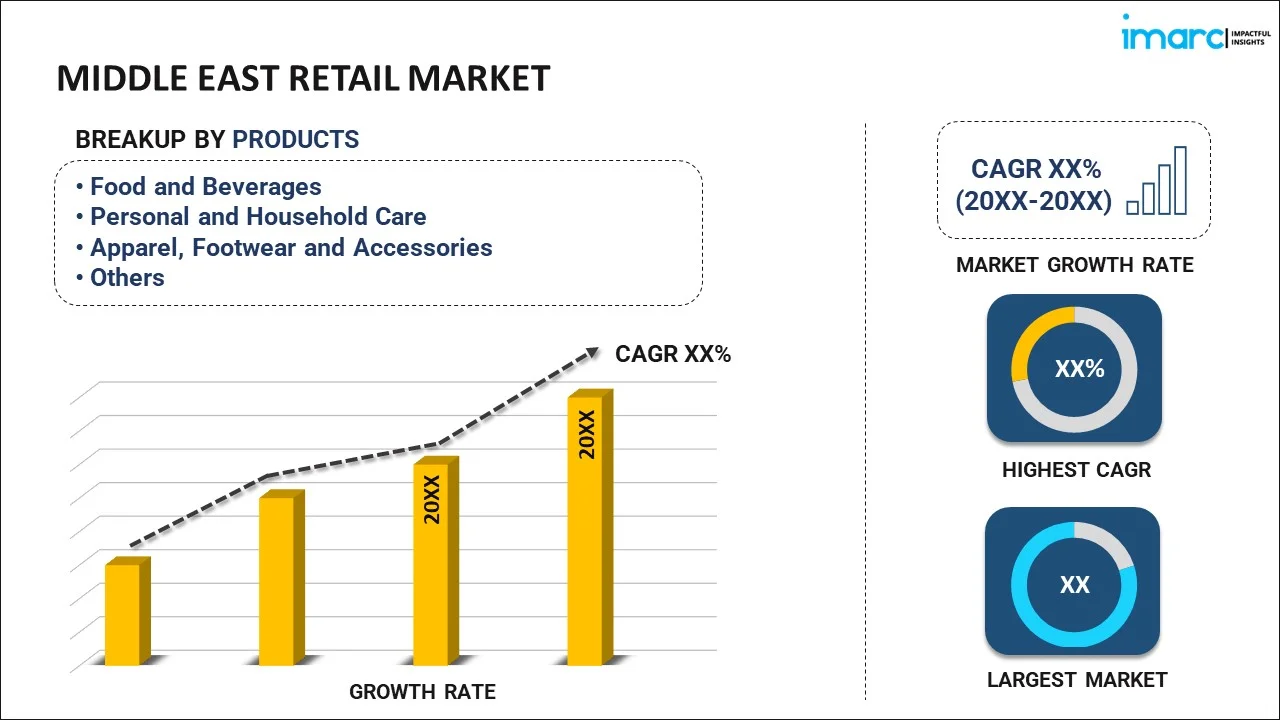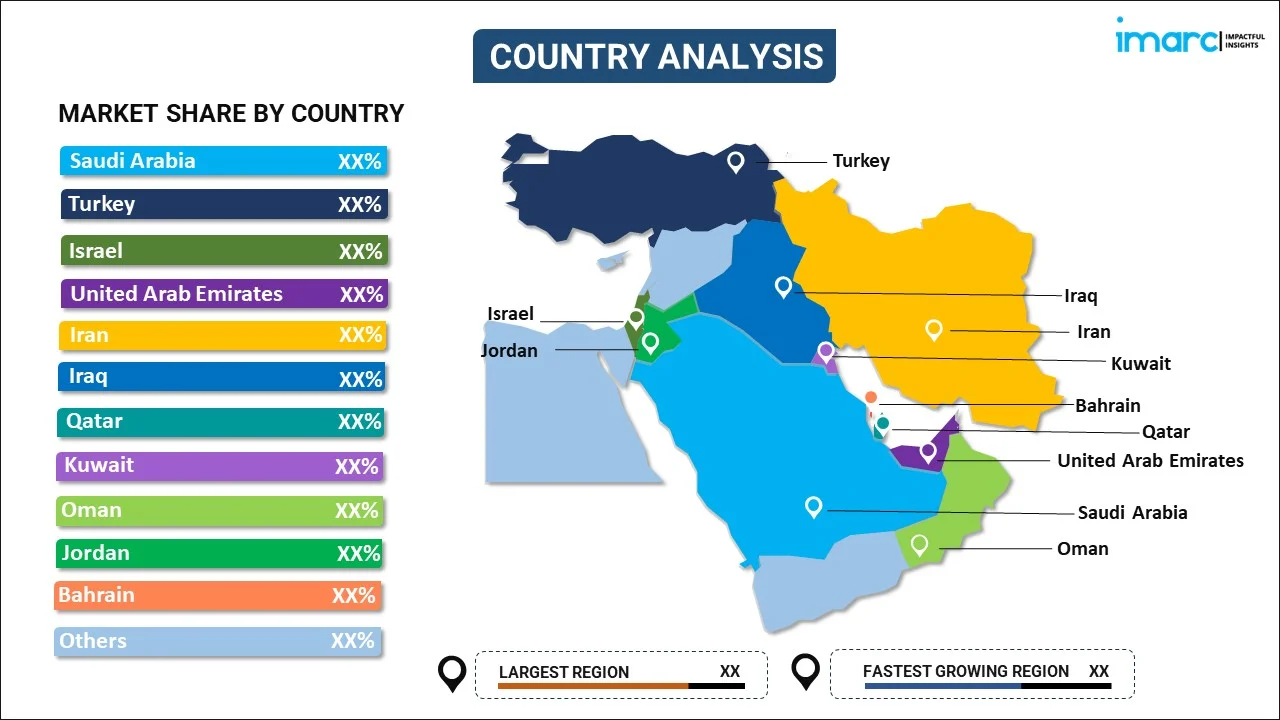
Middle East Retail Market Report by Product (Food and Beverages, Personal and Household Care, Apparel, Footwear and Accessories, Furniture, Toys and Hobby, Electronic and Household Appliances, and Others), Distribution Channel (Supermarkets and Hypermarkets, Convenience Stores, Specialty Stores, Online Stores, and Others), and Country 2025-2033
Market Overview:
Middle East retail market size reached USD 2,120 Billion in 2024. Looking forward, IMARC Group expects the market to reach USD 3,028 Billion by 2033, exhibiting a growth rate (CAGR) of 4.04% during 2025-2033. The increasing prevalence of changing demographics, including population growth, aging populations, and cultural shifts, which impact consumer preferences and buying patterns, is primarily driving the market.
|
Report Attribute
|
Key Statistics
|
|---|---|
|
Base Year
|
2024 |
|
Forecast Years
|
2025-2033
|
|
Historical Years
|
2019-2024
|
| Market Size in 2024 | USD 2,120 Billion |
| Market Forecast in 2033 | USD 3,028 Billion |
| Market Growth Rate (2025-2033) | 4.04% |
Retail is a dynamic and integral component of the economy, encompassing a vast array of businesses that sell goods and services directly to consumers. It serves as the bridge between manufacturers and end-users, offering a diverse range of products, from daily essentials to luxury items. The retail landscape has undergone significant transformation in recent years, driven by technological advancements and shifting consumer preferences. E-commerce has emerged as a formidable force, reshaping traditional brick-and-mortar models and fostering a seamless shopping experience. The sector's success hinges on understanding consumer behavior, efficient supply chain management, and creating immersive shopping environments. Retail not only stimulates economic growth but also plays a pivotal role in shaping cultural trends and social dynamics. As technology continues to evolve, the retail sector is poised for further innovation, promising an exciting future that blends online convenience with personalized in-store experiences.
Middle East Retail Market Trends:
The retail market in the Middle East is a dynamic ecosystem influenced by a multitude of factors that collectively drive its growth and evolution. Primarily, consumer preferences play a pivotal role in shaping the retail landscape. As consumers increasingly prioritize convenience and personalized experiences, retailers are compelled to adapt and innovate to meet these demands. Moreover, technological advancements act as a catalyst, revolutionizing the retail sector by introducing e-commerce platforms, mobile applications, and digital payment systems. Furthermore, economic conditions exert a significant impact on the retail market, influencing consumer spending patterns and purchasing power. During periods of economic prosperity, consumers tend to indulge in discretionary spending, propelling the retail sector forward. In essence, the regional retail market is a complex interplay of consumer behavior, technology, and economic conditions, with each factor serving as a driving force that propels the market forward and shapes its trajectory.
Middle East Retail Market Segmentation:
IMARC Group provides an analysis of the key trends in each segment of the market, along with forecasts at the regional and country levels for 2025-2033. Our report has categorized the market based on product and distribution channel.
Product Insights:

- Food and Beverages
- Personal and Household Care
- Apparel, Footwear and Accessories
- Furniture, Toys and Hobby
- Electronic and Household Appliances
- Others
The report has provided a detailed breakup and analysis of the market based on the product. This includes food and beverages, personal and household care, apparel, footwear and accessories, furniture, toys and hobby, electronic and household appliances, and others.
Distribution Channel Insights:
- Supermarkets and Hypermarkets
- Convenience Stores
- Specialty Stores
- Online Stores
- Others
A detailed breakup and analysis of the market based on the distribution channel have also been provided in the report. This includes supermarkets and hypermarkets, convenience stores, specialty stores, online stores, and others.
Country Insights:

- Saudi Arabia
- Turkey
- Israel
- United Arab Emirates
- Iran
- Iraq
- Qatar
- Kuwait
- Oman
- Jordan
- Bahrain
- Others
The report has also provided a comprehensive analysis of all the major regional markets, which include Saudi Arabia, Turkey, Israel, United Arab Emirates, Iran, Iraq, Qatar, Kuwait, Oman, Jordan, Bahrain, and Others.
Competitive Landscape:
The market research report has also provided a comprehensive analysis of the competitive landscape in the market. Competitive analysis such as market structure, key player positioning, top winning strategies, competitive dashboard, and company evaluation quadrant has been covered in the report. Also, detailed profiles of all major companies have been provided.
Middle East Retail Market Report Coverage:
| Report Features | Details |
|---|---|
| Base Year of the Analysis | 2024 |
| Historical Period | 2019-2024 |
| Forecast Period | 2025-2033 |
| Units | Billion USD |
| Scope of the Report | Exploration of Historical Trends and Market Outlook, Industry Catalysts and Challenges, Segment-Wise Historical and Future Market Assessment:
|
| Products Covered | Food and Beverages, Personal and Household Care, Apparel, Footwear and Accessories, Furniture, Toys and Hobby, Electronic and Household Appliances, Others |
| Distribution Channels Covered | Supermarkets and Hypermarkets, Convenience Stores, Specialty Stores, Online Stores, Others |
| Countries Covered | Saudi Arabia, Turkey, Israel, United Arab Emirates, Iran, Iraq, Qatar, Kuwait, Oman, Jordan, Bahrain, Others |
| Customization Scope | 10% Free Customization |
| Post-Sale Analyst Support | 10-12 Weeks |
| Delivery Format | PDF and Excel through Email (We can also provide the editable version of the report in PPT/Word format on special request) |
Key Questions Answered in This Report:
- How has the Middle East retail market performed so far and how will it perform in the coming years?
- What has been the impact of COVID-19 on the Middle East retail market?
- What is the breakup of the Middle East retail market on the basis of product?
- What is the breakup of the Middle East retail market on the basis of distribution channel?
- What are the various stages in the value chain of the Middle East retail market?
- What are the key driving factors and challenges in the Middle East retail?
- What is the structure of the Middle East retail market and who are the key players?
- What is the degree of competition in the Middle East retail market?
Key Benefits for Stakeholders:
- IMARC’s industry report offers a comprehensive quantitative analysis of various market segments, historical and current market trends, market forecasts, and dynamics of the Middle East retail market from 2019-2033.
- The research report provides the latest information on the market drivers, challenges, and opportunities in the Middle East retail market.
- Porter's five forces analysis assist stakeholders in assessing the impact of new entrants, competitive rivalry, supplier power, buyer power, and the threat of substitution. It helps stakeholders to analyze the level of competition within the Middle East retail industry and its attractiveness.
- Competitive landscape allows stakeholders to understand their competitive environment and provides an insight into the current positions of key players in the market.
Need more help?
- Speak to our experienced analysts for insights on the current market scenarios.
- Include additional segments and countries to customize the report as per your requirement.
- Gain an unparalleled competitive advantage in your domain by understanding how to utilize the report and positively impacting your operations and revenue.
- For further assistance, please connect with our analysts.
 Inquire Before Buying
Inquire Before Buying
 Speak to an Analyst
Speak to an Analyst
 Request Brochure
Request Brochure
 Request Customization
Request Customization




.webp)




.webp)












